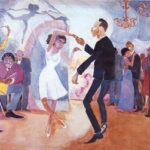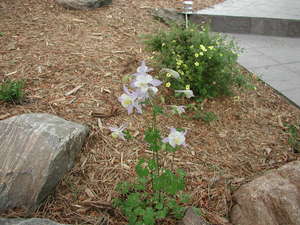It is impossible to take a look at jazz music without treading into political territory and the history of the United States. The path of jazz music simply does not tread in politics, jazz is intertwined with all levels of politics from city to federal. So tight is this bond that Rob Backus stated that “the musical basis for the national culture of the Negro Nation was laid by the birth of blues and the rise of jazz.” (Backus 22). After the Spanish-American war most of the Army bands were disbanded in the New Orleans area, this led to the hock shops being jammed with musical instruments (Backus 26). Seeing the opportunity many artists grabbed up instruments and started playing music, Louis Armstrong, like many other artists, got jobs playing on the excursion boats that traveled the rivers (26). The precursor to jazz was ragtime, which was simply the combination of blues and the syncopation of slave music (Backus 18). The hand clapping and the foot stomping that was common off beats in the slave melodies was incorporated into the left hand of the pianist, while the right hand played the syncopated parts(18). Ragtime became popular since a single piano could take the place of nearly the whole band (18). This incorporation of syncopation brought the call and response and other rhythms to the hands of jazz musicians.
When tales of higher wages and an interest in musicians came from Chicago, many artists packed up and moved north. This northern migration landed many black artists in Chicago and later New York, where with the contributions of all black artists from all genres and styles of art the Harlem Renaissance took place. This movement was monumental in helping gain respect and equality from whites. The common interest of music helped to blur the segregation lines, this blurring made a cultural and sociological stand for equality. While the Harlem Renaissance movement had many participants, there were some key figures that without their positions within magazines, newspapers, and the music industry, would have stalled the movement.
The Harlem Renaissance was lead by six artists, Jessie Redmond Fauset, Charles S. Johnson, Casper Holstein, Alain Locke, Walter White, and James Weldon Johnson, these six were dubbed by David Levering Lewis as “The Six” (Floyd 1). Through the art of music “The Six” saw an opportunity to not only use jazz as support but also as accompaniment for the Harlem Renaissance movement (3). The Six needed more than just jazz, they needed all creative talents to push towards the goal of equality. To get the movement started strong, a couple of the leaders of the Harlem Renaissance issued a call out for artists to come to Harlem from all over the U.S.A. (Floyd 2). While the Harlem Renaissance is considered to be of a literary movement, jazz music carried a very basic and very important role in the movement (3). This is very important to understand that the Harlem Renaissance was a movement much larger than the jazz music alone. During these times of jazz and new equality, many artists where trying to bridge the equality gap in society, jazz was one of the most effective tools used. While the white show world of downtown New York drew very few blacks except for some performers, Harlem after hours drew white and blacks alike, where they gathered to listen to black music (3). During the Harlem Renaissance (1924-1930), many artists in their twenties flocked to Harlem to participate in the movement, and the leaders worked to produce an image of the “New Negro” (Floyd 4). The “New Negro” would be an active community person and be socially prepared to fully integrate into an ideal America of total equality (4). This image of the “New Negro” was a suave, dapper, or even charming image of how equal black were. This image would later be embodied by Duke Ellington and other popular artists.
During the Harlem Renaissance there were two main artists that helped to bring jazz into the lime light, by performing at white-only clubs they took jazz straight to the whites (7). While jazz was created by blacks and enjoyed by blacks, the ideal audience was actual whites, where the lines of segregation could be blurred and equality could be won. Duke Ellington and Fletcher Henderson were two of the strong forces of musical nature during the Harlem Renaissance, and with Henderson playing at the Roseland Ballroom on Broadway and Ellington playing at the famed Cotton Club, they cornered the higher section of white society (7). Ellington’s rise to popularity happened to coincide with the blossoming of creative talent that is and was the Harlem Renaissance. This coincidental blossoming of popularity helped to place Duke Ellington into that image of the “New Negro”. After Duke Ellington arrived in Harlem in 1923, he rose from a basement ragtime pianist to the socially elevated position at the Cotton Club leading an orchestra of 10 players in 1927 (111). As Ellington grew in popularity he found that he had to travel more to meet the demand for his music. This traveling also led to his near complete wash of popularity over Europe. Even when his music pulled him out of town away from Harlem, Ellington continued to celebrate and use Harlem in his music (111). Many of his songs embodied such Harlem traits that even getting there by train was placed into one of his songs (111).
While Duke Ellington was rising to popularity with jazz, Countee Cullen and Langston Hughes were both publishing their first volumes of poetry (111). When Langston Hughes published his poem “The Negro Speaks of Rivers” he received wonderful acceptance by the whole black and white community (Anderson 170). With artists like Countee Cullen and Langston Hughes and Jessie Fauset as the literary editor for Crisis, written media spawned by the Harlem Renaissance was quick to find an audience which created fans and quickly rose in popularity (170). These literary arts did not stand alone in the Harlem Renaissance, but along side the power of music and paintings, these creative explosions teamed with each other truly contributed the reason why the Harlem Renaissance was a movement. By bringing the black culture into the eyes of the white population “The Six” hoped to get some black artists treated as equals which would open the flood gates of equality (Floyd 2). During the Harlem Renaissance music, Literature, and all forms of the visual arts created by black Americans not only helped to shape society but also were shaped at the same time by the society as black Americans saw it (Floyd 139). This is a very interesting point of view since many of the perceptions about reality for blacks was shaped by the imposing of strict rules, restrictive and discriminating social and political conditions, which lead to a “double-Consciousness”(139). Inadvertently segregation had actually caused this development of this unique view where commenting on the human condition and the world, was part of the examined life (139). This inward view on life is what gave the poetry and art such great power and meaning, without these strong social views and beliefs the art would be hard to set aside from regular painting, music and literature. Thankfully due to the unique views and struggles of the black culture about society and the Harlem Renaissance movement jazz became very popular and still is today.
Jazz music did not find immediate success though, it should be noted that there were many hard times, and there was tons of prejudice against jazz and any form of black music. For a long time all black music was regarded to as vulgar or even “Jungle” music. These stereotypes of the music was carried over from the older racism that blacks themselves were vulgar, heathens, or jungle based. There are many accounts of police harassing jazz musicians like Art Blakey, who spend a night in jail being beaten for no good reason (Backus 64). To this day Art Blakey still has a silver plate in his forehead from that night (64). Then there is the infamous incident with Miles Davis, who took a beating to the head during a smoke break (65). Across the country in New York when Archie Shepp, Marion Brown, and a few others were practicing, the New York swat team came in for a noise disturbance (65). These are all great examples of how badly the equality lines where shifted to one side. When the leaders of the Harlem Renaissance took up this movement, they knew they were risking everything that they had acquired in life. Like many brave souls before them, they felt that the possible total sacrifice was worth it for the greater good. These musicians and artists, on a daily basis put forth true blood, sweat and tears.
Works Cited
Anderson, Paul. Deep River. Duke University Press. 2001
Backus, Rob. Fire Music. Vanguard Books. Chicago, 1978
Floyd, Samuel. Black Music in the Harlem Renaissance. Greenwood Press. New York, 1990




